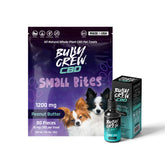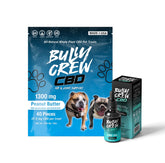Honey, often called the nectar of the Gods, offers a range of health benefits for both humans and dogs. We usually use honey to soothe sore throats or ease seasonal allergies. Still, you may wonder if a dog can eat honey or if it's also safe and beneficial for dogs. Can honey really support your dog's health? Is it safe to give your dog honey? And if so, how should you use it?
While honey is mainly known as a sweetener, it's packed with nutrients like vitamins A, B, C, D, E, and K, along with minerals such as zinc, iron, calcium, and more. In its raw form, honey has antifungal, antibacterial, and antimicrobial properties and powerful antioxidants. These qualities make honey for dogs a beneficial addition to your dog's diet, offering several health benefits.
Is Honey Safe For Dogs?
Yes, honey is healthy for dogs and can be used on their skin. You can mix honey into your dog's food or apply it to minor cuts or scrapes to help heal. However, limiting how much your dog eats is important since honey is sweet. Giving your dog no more than one tablespoon of honey daily helps prevent tooth decay and weight gain. Moderation is vital to keeping your dog healthy while enjoying the benefits of honey.
Health Benefits of honey for dogs
When we discuss the health benefits of honey, we're referring to raw, unpasteurized honey. Processed or heated honey often has added ingredients like high fructose corn syrup, which reduces its health benefits. Just like for people, raw honey can help with a range of issues, including:
- Antioxidants in honey, including vitamins A, C, and E, as well as phenolic acid and flavonoids, help protect your dog's cells from damage caused by free radicals. These antioxidants also reduce inflammation and support your dog's immune system.
- B-complex vitamins are essential for your dog's health. They help boost energy, support brain function, and aid metabolism.
- Honey has antimicrobial, antifungal, and antibacterial properties. Its enzymes help reduce inflammation and soothe sore throats and stomach ulcers. When applied to the skin, honey for dog can heal wounds, hot spots, eczema, and bug bites. Eating honey can also help eliminate harmful bacteria in the stomach that can cause diarrhea.
- Honey has anti-inflammatory properties that can benefit senior dogs and honey can also help with joint pain and inflammation from hot spots, wounds, or bug bites.
- For seasonal allergy relief, honey for dogs allergies can help because it contains small amounts of flower pollen. This pollen can boost your dog's immune system and help it build antibodies to reduce allergic reactions.
- Small amounts of honey can help with digestive problems like diarrhea and vomiting because it has anti-inflammatory properties.
- Like any cough, kennel cough can be eased with honey. It soothes the throat, making it easier to swallow, and its antibacterial properties may help fight the infection.
What type of honey is safe for dogs?
Honey comes in many types because different bees collect nectar from various plants. Manuka honey, from New Zealand, is known for its powerful antibacterial properties and high nutrient content. It's beneficial for easing your dog's cough or throat irritation.
Other honey types, such as dandelion, meadow, heather, honeydew, jarrah, and tupelo, are packed with antioxidants.
For the best health benefits, choose raw, unfiltered, and locally sourced honey. Avoid processed or pasteurized honey, as it may lose its valuable properties during production.
How do I give my dog honey?
To help with internal issues, give your dog 1 tablespoon of local honey each day. You can mix it into their food or let them enjoy it straight from a spoon. Local honey is ideal because it contains local pollen, which can help your dog build immunity to seasonal allergies.
You can apply honey directly to your dog's skin for external issues. Just remember that dogs love the taste of honey and might try to lick it off. You may need to cover the area with a bandage to keep the honey in place.
Honey's benefits are even better when combined with full-spectrum hemp CBD, which is used for issues like hot spots, allergies, and bug bites. With topical use, you should notice improvements in a few days and within a few weeks if you use honey orally.
How much honey can dogs have safely?
Honey is very sugary, and even though it's natural, it can be problematic for dogs with diabetes, obesity, or weakened immune systems. If your dog has any of these conditions, it's best to avoid giving them honey and consult your vet first.
One teaspoon of honey has 17 grams of sugar and 70 calories. Generally, most dogs can handle it, and honey is okay for dogs with up to one teaspoon of honey per day. Here are some guidelines based on your dog's weight:
Illustration:
Dog Size Honey Consumption
Small (10 lbs) ¼ teaspoon per day
Medium (10-20 lbs) ½ teaspoon per day
Large (20-50 lbs) one teaspoon per day
Larger (over 50 lbs) 2 teaspoons per day
Conclusion
So, can dogs eat honey? While there aren't many scientific studies backing all the claims about honey and dogs, its long history of use and positive anecdotal evidence suggests it has real benefits. Honey is a superfood packed with antioxidants, vitamins, and minerals. It can help with allergies, soothe skin irritations, and provide a quick energy boost for your fur baby.
Raw honey is generally safe for most adult dogs when used in moderation. Hence, adding a bit of honey to your dog's treats or food to enhance their health and well-being goes a long way toward promoting their overall health.
Related:







